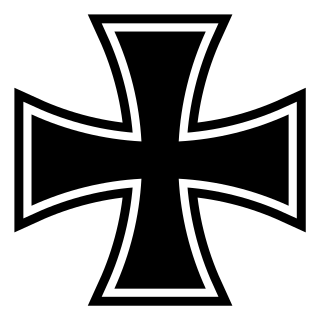
The Iron Cross is a former military decoration in the Kingdom of Prussia, and later in the German Empire (1871–1918) and Nazi Germany (1933–1945). It was established by King Friedrich Wilhelm III of Prussia on 17 March 1813 during the Napoleonic Wars. The award was backdated to the birthday of his late wife Queen Louise. Louise was the first person to receive this decoration (posthumously). The recommissioned Iron Cross was also awarded during the Franco-Prussian War, World War I, and World War II. The Iron Cross awarded during World War II has a swastika in the center. The Iron Cross was normally a military decoration only, though there were instances of it being awarded to civilians for performing military functions. Two such examples were Hanna Reitsch, who received the Iron Cross 2nd Class and Iron Cross 1st Class, and Melitta Schenk Gräfin von Stauffenberg, who received the Iron Cross 2nd Class. Both were civilian test pilots during World War II.

The Order of the Red Eagle was an order of chivalry of the Kingdom of Prussia. It was awarded to both military personnel and civilians, to recognize valor in combat, excellence in military leadership, long and faithful service to the kingdom, or other achievements. As with most German orders, the Order of the Red Eagle could only be awarded to commissioned officers or civilians of approximately equivalent status. However, there was a medal of the order, which could be awarded to non-commissioned officers and enlisted men, lower ranking civil servants and other civilians.

The Royal Norwegian Order of Saint Olav is a Norwegian order of chivalry instituted by King Oscar I on 21 August 1847. It is named after King Olav II, known to posterity as St. Olav.

The House Order of Hohenzollern was a dynastic order of knighthood of the House of Hohenzollern awarded to military commissioned officers and civilians of comparable status. Associated with the various versions of the order were crosses and medals which could be awarded to lower-ranking soldiers and civilians.

The Austrian Imperial Order of Leopold was founded by Franz I of Austria on 8 January 1808. The order's statutes stipulated only three grades: Grand Cross, Commander and Knight. During the war, in common with the other Austro-Hungarian decorations, crossed swords were instituted to reward bravery in the face of the enemy. An Imperial Decree of 1 February 1901 ordered that in future, the senior grade would be split into two separate awards. From then onwards, there were four ranks: Grand Cross, First Class, Commander, Knight.

The Bavarian Military Merit Cross (Militär-Verdienstkreuz) was that kingdom's main decoration for bravery and military merit for enlisted soldiers. It was intended "to reward extraordinary merit by non-commissioned officers, soldiers, and lower-ranking officials." It was originally established on July 19, 1866 as the 5th Class of the Military Merit Order, which was the main decoration for bravery and military merit for officers and higher-ranking officials. Civilians acting in support of the army were also made eligible for the decoration.
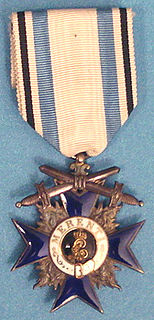
The Bavarian Military Merit Order was established on July 19, 1866 by King Ludwig II of Bavaria. It was the kingdom's main decoration for bravery and military merit for officers and higher-ranking officials. Civilians acting in support of the army were also made eligible for the decoration. The Military Merit Order ranked below the Military Order of Max Joseph (Militär-Max-Joseph-Orden), which was Bavaria's highest military honor for officers.

The Military Merit Cross (Militär-Verdienstkreuz) was the highest bravery award of the Kingdom of Prussia for non-commissioned officers and enlisted soldiers. It was also known as the Golden Military Merit Cross to distinguish it from the Military Decoration 1st Class, a lesser Prussian enlisted bravery decoration which was an identical cross but in silver. The Military Merit Cross came to also be known as the "Pour le Mérite for non-commissioned officers and enlisted men", after the Pour le Mérite, Prussia's highest military decoration for officers.
Orders, decorations, and medals of the German Empire covers those decorations awarded by the states which came together under Prussian leadership to form the German Empire in 1871. For convenience's sake, this category also covers the decorations of the various German states which were no longer in existence in 1871, mainly because they had been annexed by Prussia during the Wars of Unification or before.

The House and Merit Order of Duke Peter Frederick Louis or proper German Oldenburg House and Merit Order of Duke Peter Frederick Louis was a civil and military order of the Grand Duchy of Oldenburg, a member state of the German Empire. The order was founded by Grand Duke Augustus of Oldenburg on November 27, 1838, to honor his father, Peter Frederick Louis of Oldenburg. It became obsolete in 1918 after the abdication of the last grand duke.

The Military Order of Max Joseph was the highest military order of the Kingdom of Bavaria. It was founded on 1 January 1806 by Maximilian I Joseph of Bavaria, the first king of Bavaria. The order came in three classes:
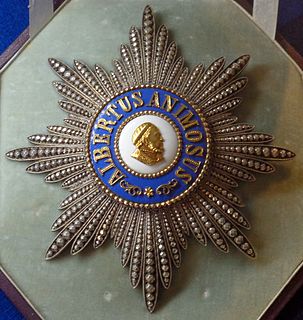
The Albert Order was created on 31 December 1850 by King Frederick Augustus II of Saxony to commemorate Albert III, Duke of Saxony. It was to be awarded to anyone who had served the state well, for civil virtue, science and art.

The Red Cross Medal was a German medal set up on 1 October 1898 by Wilhelm II. It had three classes and could be awarded to all those who carried out great service to the sick in peace or wartime, or for special achievement in the service of the German Red Cross. Though service to the sick during times or war had been recognized with prior awards of the Order of the Crown and General Honor Decorations with the Red Geneva Cross, Empress Augusta Victoria the royal patroness of the organization wanted an award to recognize work in peacetime as well.
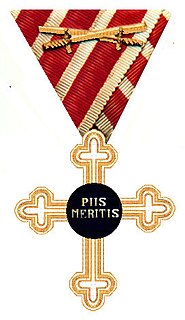
This is a list of Orders, decorations, and medals of Austria-Hungary.
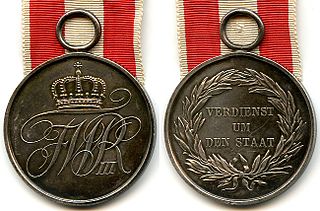
The General Honor Decoration was a decoration of Prussia. The decoration can trace its origin back to awards established in 1793 by King Frederick William III of Prussia. The various levels of the decoration recognized peacetime merit to Prussia. These awards were often to commemorate long and particularly meritorious service or for special contributions from people who would not be considered for appointment to an order due to their rank. In general, recipients were lower and mid-level officials and officers.
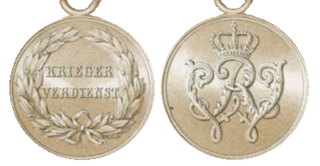
Military decoration of Prussian Army

The Merit Cross for War Aid was a war decoration of Prussia awarded during World War I. Instituted 5 December 1916, the cross was awarded for patriotic war aid service, without regard to status or rank.

The Military Honor Medal was a two-class military decoration awarded by the Kingdom of Prussia. The medal was awarded to military personnel from the rank of sergeant and below. Established in 1814, it replaced the Gold Military Merit Medal of 1806, with a medal in the shape of a cross silver cross for the 1st class while the Silver Military Medal of 1806 became the 2nd class with minor changes in design.

The Jerusalem Cross or Jerusalem Memorial Cross was a decoration of Prussia established 31 October 1898. The cross was awarded to those who traveled with Emperor Wilhelm II on his 1898 visit to Palestine and attended the inauguration of the Lutheran Church of the Redeemer, Jerusalem.

The House Order of Fidelity is a dynastic order of the Margraviate of Baden. It was established by Charles III William, Margrave of Baden-Durlach as a reward for merit and to mark the laying of the foundation stone of his residence at Karlsruhe Palace. As was customary at that time, it was originally named in French as the Ordre de la Fidélité, before later being renamed the Orden der Treue and finally in 1840 the Hausorden der Treue. Its motto was Fidelitas, which is also part of Karlsruhe's coat of arms.




















